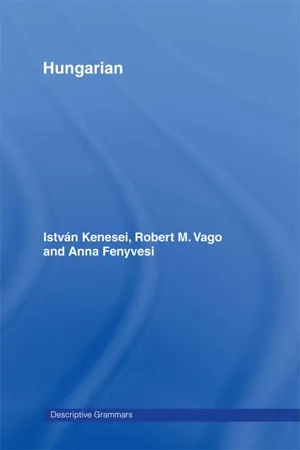
This is a test
- 512 pages
- English
- ePUB (mobile friendly)
- Available on iOS & Android
eBook - ePub
Hungarian
Book details
Book preview
Table of contents
Citations
About This Book
Hungarian is spoken by 12-14 million people worldwide. A unique language, completely unrelated to the languages of its neighbouring countries, it boasts a grammar full of complex features and a vocabulary deriving largely from Asia.
Hungarian addresses current issues in the description of languages and applies up-to-date research techniques to Hungarian. This is the first comprehensive descriptive grammar of the Hungarian language available in English.
Frequently asked questions
At the moment all of our mobile-responsive ePub books are available to download via the app. Most of our PDFs are also available to download and we're working on making the final remaining ones downloadable now. Learn more here.
Both plans give you full access to the library and all of Perlego’s features. The only differences are the price and subscription period: With the annual plan you’ll save around 30% compared to 12 months on the monthly plan.
We are an online textbook subscription service, where you can get access to an entire online library for less than the price of a single book per month. With over 1 million books across 1000+ topics, we’ve got you covered! Learn more here.
Look out for the read-aloud symbol on your next book to see if you can listen to it. The read-aloud tool reads text aloud for you, highlighting the text as it is being read. You can pause it, speed it up and slow it down. Learn more here.
Yes, you can access Hungarian by Istvan Kenesei, Robert M. Vago, Anna Fenyvesi in PDF and/or ePUB format, as well as other popular books in Languages & Linguistics & Linguistics. We have over one million books available in our catalogue for you to explore.
Information
Chapter 1
Syntax
1.1. GENERAL QUESTIONS
1.1.1. Sentence-types
1.1.1.1. Direct and quoted speech
There is no difference between direct and quoted speech; no quotative mood exists in the language, and, except for the somewhat archaic or literary úgymond ‘thus speaks’, there is no marker of quoted statements.
(1) | Péter, úgymond, beteg volt. Peter thus-speaks sick was ‘It is said that Peter was sick.’ |
Moreover, except for the predictable changes in reference, there are no structural differences between direct and indirect speech as regards word order, modality or tense, as will be seen in 1.1.2.2–5 below.
1.1.1.2. Interrogative sentences
The two main question-types, question-word and yes–no questions, are differentiated by intonation, word-order, and the specific interrogative elements (question-word versus clitic) used, each discussed in turn below.
1.1.1.2.1. Yes–no questions
Yes–no questions have a characteristic rising–falling, i.e., low–high–low, intonation pattern, within which the first syllable of the question is low, the penultimate is the last one bearing high, and the last syllable of the question is low – if it has at least three syllables. If the question does not consist of more than two syllables, the final low may be omitted. For more, see 3.3.4.1 and Varga (1994).
1.1.1.2.1.1. Neutral The order of constituents in a neutral yes–no question does not differ from that seen in noninterrogatives, and it is a possible strategy – in fact, the most frequent strategy – to ask yes–no questions purely by changing the intonation in the manner described above.
(2) | a. | Péter beteg volt. Peter sick was ‘Peter was sick.’ |
b. | Péter beteg volt? ‘Was Peter sick?’ |
In main clause yes-no questions it is possible to apply the clitic -e (marked by “Q” below), which is attached to the finite verb in Standard Literary Hungarian. The intonation is falling, i.e., the same as in declarative sentences. The meaning is not quite the same as in the simple intonational question, which qualifies as a common inquiry; the -e clitic in main clause questions presupposes some common ground or appears as drawing and ascertaining some inference. (The hyphen between the clitic and the verb is required by the rules of Hungarian orthography. Note that in general only the definite conjugation is glossed, the indefinite conjugation being the null case in most instances.)
(3) | a. | Péter beteg volt-e? Peter sick was-Q ‘Was Peter (indeed) sick?’ |
b. | Anna Szeged-en dolgoz-ik-e? Anna Szeged-SUP work-3SG-Q ‘Does Anna (really) work in Szeged?’ |
Adjunction of the clitic to the negation word or the preverbal prefix (= PFX) immediately in front of the finite verb is widespread, though ostracized by purists. In both pairs of examples below, the standard forms are given under (a), then the nonstandard ones under (b), marked by the “%” sign.
(4) | a. | Péter nem volt-e beteg? Peter not was-Q sick. |
b. | %Péter nem-e volt beteg? ‘Wasn’t Peter sick?’ | |
(5) | a. | Anna meg-talál-t-a-e a válasz-t? Anna PFX-find-PAST-3SG.DEF-Q the answer-ACC |
b. | %Anna meg-e találta a választ? ‘Has Anna found the answer?’ |
The interrogative expletive vajon can occur optionally in both yes–no and question-word questions, with the slight meaning change that, if unaccompanied by the -e clitic, it carries less the meaning of an inquiry to another interlocutor than a question addressed to oneself. The presence of vajon does not change the intonation of the sentence determined by independent factors: falling in q...
Table of contents
- Front Cover
- Half Title
- Title Page
- Copyright
- Contents
- Symbols and abbreviations
- Orthographic and phonemic correspondences
- Introduction
- CHAPTER 1. SYNTAX
- CHAPTER 2. MORPHOLOGY
- CHAPTER 3. PHONOLOGY
- CHAPTER 4. IDEOPHONES AND INTERJECTIONS
- CHAPTER 5. LEXICON
- REFERENCES